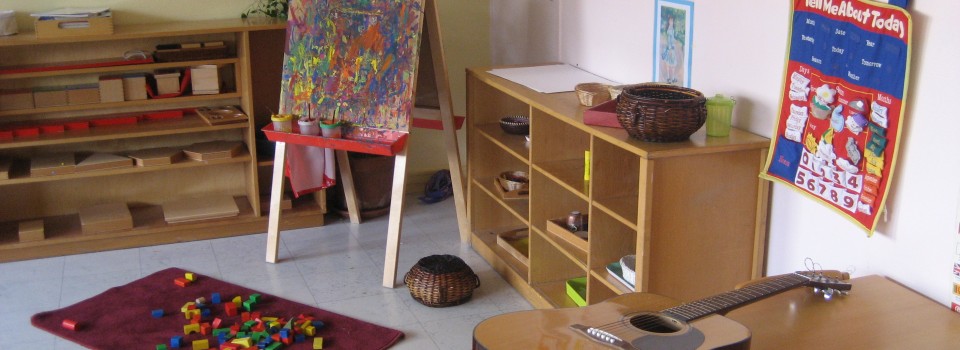It meets the child’s needs: “Help me do it myself”.
Maria Montessori defines the child’s mind as absorbent, which allows him to absorb his surroundings like a sponge. It is a time for conscious development.
“The hands are the instruments of man’s intelligence. They will now help him to develop.”
The child goes through sensitive periods for order, movement and language.
The children’s house lays the basic elements for social life for the child to live a peaceful, conscious and responsible life.
Everything is adjusted to the child’s size and strength: the material, the furniture which is carefully chosen for its looks because children are attracted to beauty.
The children’s house has three objectives:
- to create and develop self-esteem;
- to reveal self-esteem;
- to develop an independent personality.
The majority of the activities are done individually and there is only one copy of each material in the classroom, which develops the sense of responsibility and sociability of the child.
The child chooses his activities freely, at his own pace (he can take the time to think and observe) and can freely access the material if it has already been presented by the educator. This also develops the child’s autonomy.
The material in the children’s house:
- LIFE-SKILLS MATERIAL, composed of everyday objects with which he can sew, cut and draw, wash the table and sweep the floor, get dressed etc… and therefore assimilate the gestures of his cultural group. The child develops self-esteem and autonomy.
- SENSORY MATERIAL are materialized abstractions that allow the child to build and develop his logical thinking skills. This material introduces notions that the child will be able to transfer to bigger and bigger things. It also allows the child to center his tactile and auditory skills in order to control himself and his surroundings (shapes, colors, weight, space etc…)
- LANGUAGE MATERIAL opens the door to sounds, languages, writing and reading.
- MATH MATERIAL introduces more complex abstractions through discovering numbers, logic etc…
LIFE-SKILLS MATERIAL
Life-skills material is always presented first because it gets the child’s interest and determines his will to act. The young child will grow through manipulation. Maria Montessori said that “children grow in movement”.
The material is presented in order of use, which helps the child get his bearings and organize his work. Through manipulation, the child paves his own way to discovery, develops logic, determines his gestures and develops autonomy by doing more and more activities on his own.
SENSORY MATERIAL
From a very young age, from birth to 3 years old, the child learns without effort. The sensory material will help him understand, precise and categorize his perception. Each material becomes a support to help him understand his surroundings. The material helps the child go from concrete to abstract, helps him compare and deduce. Through manipulation, the child makes assumptions and deduces. The sensory material is a basis for math or language material, which requires the child to use abstraction and more thinking.
LANGUAGE MATERIAL
Images, poems, games help the child develop his oral expression and tell stories. They also develop his listening skills, his way of thinking and his vocabulary.
Preparation for writing is done through sound analysis. Using shapes and drawings helps develop designs, ridged letters help him memorize the sound of letters and their calligraphy and combine 3 senses (sight, hearing and touch). The child learns the sound and shape of each letter at the same time. The mobile alphabet allows the child to create words with letters, then sentences. As soon as the child can read the words he makes, he is ready to read. The language material then helps him become aware of the grammatical organization of the language. The child therefore discovers the different elements that make up a sentence.
MATH MATERIAL
Each day, in his close community, the child becomes aware of quantities. We teach him to count the objects of his surroundings: his friends, the absents, etc… The math material is sensorial: the child learns units, dozens or hundreds and discovers math basics (decimal system, addition, subtraction, multiplication and division). With this material, we discover 3 aspects of reality: numbers, shapes (geometry i.e. representation), structure and transformation (algebra).
 English
English  Français
Français 


